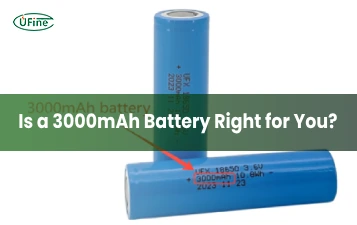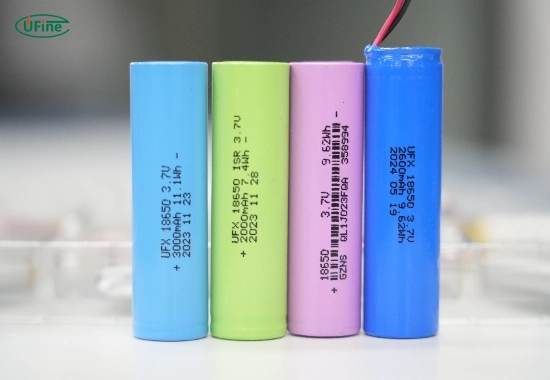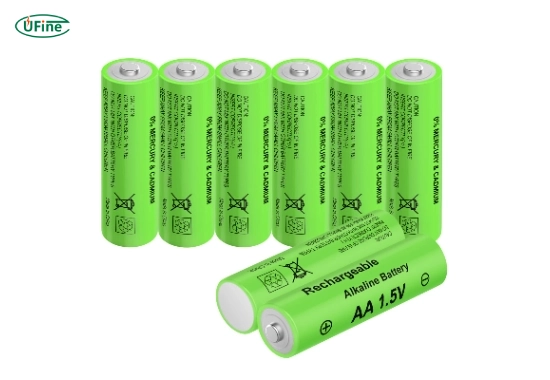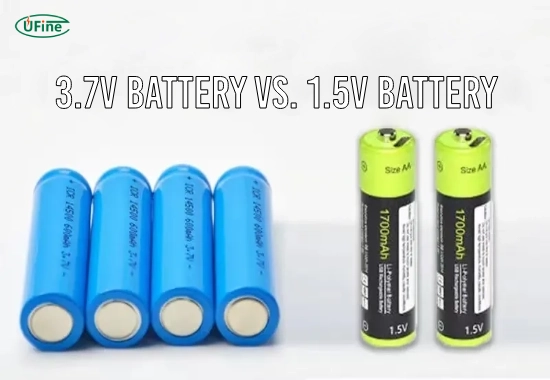In the world of portable electronics, understanding the differences between a 3.7V Battery and a 1.5V Battery is crucial for making informed decisions about power sources for your devices. Batteries are not just simple power units; they significantly influence our gadgets’ performance, efficiency, and longevity. This article will explore both battery types, characteristics, advantages, and applications, providing a comprehensive comparison to help you choose the right one for your needs.
Part 1. Understanding 3.7V batteries
3.7V batteries, commonly known as lithium-ion (Li-ion), have become the standard power source for many modern electronic devices, such as smartphones, laptops, and tablets. These batteries are favored for their high energy density, allowing them to store much energy in a compact form.
Advantages of 3.7V Batteries
- High Energy Density: One of the standout features of Li-ion batteries is their ability to store more energy per unit weight or volume compared to traditional battery types like nickel-cadmium or lead-acid batteries.
- Rechargeability: Li-ion batteries can be recharged hundreds of times without significant loss in capacity, making them a sustainable option for powering devices.
- Long Lifespan: With proper care, these batteries can last several years, providing reliable power over extended periods.
- Low Self-Discharge Rate: Unlike other battery types that lose charge when not in use, Li-ion batteries retain their charge well over time.
- No Memory Effect: Users can recharge Li-ion batteries at any time without worrying about reducing their overall capacity, unlike older battery technologies that require total discharges before recharging.
Applications of 3.7V Batteries
Many devices use 3.7V batteries in:
- Consumer Electronics: Smartphones, laptops, tablets, and cameras.
- Electric Vehicles: Many electric vehicles utilize Li-ion technology for efficient energy storage.
- Portable Devices: Due to their compact size and high capacity, these batteries are used in power banks and other portable charging solutions.
Part 2. Understanding 1.5V batteries
1.5V batteries, primarily alkaline batteries, are one of the most common primary (non-rechargeable) batteries available today. People use them in everyday devices such as remote controls, flashlights, and toys.
Advantages of 1.5V Batteries
- Cost-Effective: Alkaline batteries are generally less expensive than rechargeable, making them an economical choice for many applications.
- Widespread Availability: These batteries can be found in almost every retail outlet and come in various sizes (AA, AAA, C, D) to fit different devices.
- Long Shelf Life: Alkaline batteries can be stored for years without significant loss of charge, making them ideal for emergency supplies.
- Ease of Use: Insert the battery into the device, and it’s ready to go; no charging is necessary.
Applications of 1.5V Batteries
Many devices commonly use 1.5V batteries in:
- Household Devices: Remote controls, wall clocks, and smoke detectors.
- Toys: Many battery-operated toys rely on alkaline batteries for power.
- Flashlights: Portable lighting solutions often use these readily available batteries.
Part 3. Key differences between 3.7V and 1.5V batteries
Electronic devices use both 3.7V and 1.5V batteries, but several key differences exist between them:
- Voltage: The most obvious difference is the nominal voltage. 3.7V batteries have a higher voltage than 1.5V batteries, which means they can provide more power to devices that require higher voltages.
- Rechargability: 3.7V batteries are rechargeable, while 1.5V batteries are primary (non-rechargeable) batteries. This means you can use 3.7V batteries repeatedly, while you must replace 1.5V batteries once depleted.
- Energy density: As mentioned earlier, 3.7V batteries have a higher energy density than 1.5V batteries, allowing them to store more energy in a smaller, lighter package.
- Cost: 1.5V batteries are generally less expensive than 3.7V batteries, especially when considering the price of recharging devices with 3.7V batteries over time.
- Safety: Both battery types have safety considerations. However, 3.7V batteries may require more care when charging and discharging to prevent overheating or fire.
| Feature | 3.7V Battery | 1.5V Battery |
|---|---|---|
| Voltage | Higher voltage (3.7V) | Standard voltage (1.5V) |
| Rechargeability | Rechargeable | Non-rechargeable |
| Energy Density | Higher energy density | Lower energy density |
| Cost | Generally more expensive | Generally less expensive |
| Self-Discharge Rate | Low self-discharge | Moderate self-discharge |
Part 4. Choosing the right battery for your needs
Selecting between a 3.7V battery and a 1.5V battery involves considering several factors based on your specific requirements:
Voltage Requirements
Always check your device’s voltage requirements before purchasing a battery. Using a battery with insufficient voltage may result in poor performance or device failure.
Power Requirements
Consider how much power your device consumes during operation:
- For high-drain devices like smartphones or laptops that require consistent high power output, a 3.7V lithium-ion battery is typically more suitable due to its higher energy density.
- A 1.5V alkaline battery is sufficient and cost-effective for low-drain devices like remote controls or wall clocks that don’t require frequent power bursts.
Rechargeability vs Non-Rechargeability
- If you frequently use devices that require replacement batteries, investing in rechargeable 3.7V Li-ion batteries can save money over time despite their higher initial cost.
- Conversely, if you need a quick solution for occasional use—like powering a flashlight during an emergency—1.5V alkaline batteries may be more convenient since they do not require charging.
Environmental Considerations
When considering environmental impact:
- Lithium-ion batteries are rechargeable and reduce waste over time but require proper disposal due to their chemical components.
- Alkaline batteries are generally considered safe for regular disposal but should still be recycled when possible to minimize environmental impact.
Part 5. FAQs
-
Can I use a 1.5V battery in a device that requires a 3.7V battery?
No, using a lower-voltage battery, like a 1.5V battery, in a device designed for a 3.7V battery can cause malfunction or damage to the device due to an insufficient power supply. -
How long do 3.7V batteries last compared to 1.5V batteries?
Battery lifespan varies depending on usage and device type. Generally, users can recharge 3.7V batteries multiple times, allowing them to last longer. In contrast, single-use alkaline batteries deplete after one use cycle. -
Are 3.7V batteries more expensive than 1.5V batteries?
While the upfront cost of rechargeable Li-ion (3.7V) batteries is typically higher than that of disposable alkaline (1.5V) batteries, they may offer better value over time when considering their longevity and reusability. -
Can I use a 3.7V battery in a device that requires a 1.5V battery?
No, using a higher-voltage battery, like 3.7V, in place of the required 1.5V can damage the device due to excessive voltage input, which may lead to overheating or component failure. -
Are there safety concerns with using either type of battery?
Both types have safety considerations; however, lithium-ion (3.7V) requires careful handling during charging and discharging to avoid risks like overheating or fire hazards if improperly managed. At the same time, alkaline (1.5V) generally poses fewer risks but should still be disposed of responsibly to prevent environmental harm.
Related Tags:
More Articles

Is a 3000 mAh Lithium Battery Enough for Your Device?
Wondering what a 3000mAh battery means? Learn about its power, lifespan, types, and how to choose the best one for your device!
Learn About Lithium Battery Kits
Discover the ultimate guide to lithium battery kits—types, safety, installation, and cost analysis. Make the right choice for solar, RV, or off-grid power!
Selecting the Perfect Ah for Your 48V Li-ion Battery Pack
Struggling to choose the right Ah for your 48V Li-ion battery pack? This in-depth guide covers everything you need to make the best choice. Find out more now!
LiFePO4 Pouch Cells Explained: Advantages, Applications & Comparison
Learn all about LiFePO4 pouch cells, their structure, lifespan, advantages, and how they outperform other lithium battery types. Make the right choice!
12Ah Lithium Battery Guide: Uses, Lifespan & Tips
12Ah lithium batteries last longer, charge faster & weigh less than lead-acid. See best uses, charging tips & how to extend lifespan!






